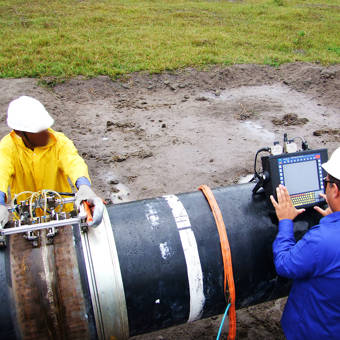Take Full Advantage Of Effectiveness: Proactive Pipeline Welding Inspection Methods
Comprehensive Introduction of Pipeline Welding Evaluation Treatments
Pipe welding examination procedures play a critical duty in ensuring that welded links satisfy rigid sector criteria and specs. From thorough pre-welding evaluations to comprehensive post-weld assessments, a distinct evaluation process is necessary for preserving the structural stability of pipelines.
Pre-welding Examination Preparations
Prior to commencing the welding process, thorough pre-welding inspection prep work are vital to guarantee the honesty and high quality of the weld joint. These preparations involve a thorough examination of the materials to be welded, the welding devices, and the workplace. Firstly, the products need to be checked for any kind of defects, pollutants, or incongruities that could compromise the weld. This consists of checking for correct material grades, measurements, and surface area problems. Pipeline Welding Inspection. Additionally, the welding equipment requires to be examined to confirm that it remains in good functioning problem, calibrated correctly, and suitable for the particular welding procedure. Any concerns with the equipment should be resolved without delay to avoid defects in the weld. Finally, the work setting need to be assessed for sanitation, proper ventilation, and safety and security measures to make certain a favorable setting for the welding procedure. By conducting thorough pre-welding examination preparations, potential concerns can be determined and dealt with beforehand, causing top quality and dependable weld joints.
Welding Treatment Credentials
Thorough pre-welding examination preparations lay the structure for the critical process of Welding Procedure Credentials, guaranteeing the honesty and high quality of the weld joint. Welding Treatment Qualification (WPQ) is an essential action in the welding procedure that includes testing and accrediting welding procedures to assure they satisfy specific standards and needs. The WPQ process usually includes welding procedure specification development, welding procedure certification testing, and documents of the outcomes.
During welding treatment requirements growth, important information such as the welding process, welding products, joint layout, and welding criteria are defined to create a thorough treatment. Consequently, welding procedure certification testing is conducted to verify the recommended procedure's stability. This testing frequently involves welding test vouchers that are subjected to numerous mechanical and non-destructive tests to evaluate the weld's top quality and adherence to the defined requirements.
In-process Weld Evaluation
During the welding process, in-process weld evaluation plays a vital role in making sure the high quality and stability of the weld joint - Pipeline Welding Inspection. This sort of examination involves keeping track of the welding criteria, evaluating the weld bead development, and detecting any type of potential flaws or stoppages as they happen. By conducting in-process weld inspections, welding operators can immediately resolve any kind of problems that might arise, thereby ensuring and preventing additional defects that the final weld meets the required requirements
Usual approaches utilized for in-process weld evaluation consist of aesthetic assessment, fluid penetrant testing, magnetic fragment testing, ultrasonic screening, and radiographic screening. Overall, in-process weld examination is essential for keeping the quality and dependability of bonded pipelines.
Non-destructive Testing (NDT)
Non-destructive Screening (NDT) is a crucial technique used in pipe welding evaluation to examine the honesty of weld joints without causing damage to the welded framework. By making use of numerous NDT techniques, examiners can examine the top quality of welds and recognize any defects or gaps that might endanger the architectural soundness of the pipeline. Common NDT methods made use of in pipeline welding inspection include Radiographic Testing (RT), Ultrasonic Testing (UT), Magnetic Particle Evaluating (MPT), Liquid Penetrant Testing (LPT), and Visual Testing (VT)
RT entails the usage of X-rays or gamma rays to create my review here pictures of the internal structure of the weld, permitting examiners to detect flaws such as porosity, additional hints cracks, or incomplete blend. Additionally, VT involves visual assessment of welds to determine any kind of noticeable blemishes.
Post-weld Assessment and Documentation

Documentation of post-weld inspection searchings for is important for maintaining quality assurance documents and making sure compliance with market standards and Resources regulations. In-depth reports ought to include details about the inspection techniques utilized, the place and nature of any kind of issues located, and any kind of rehabilitative actions taken - Pipeline Welding Inspection. Appropriate paperwork not just serves as a document of the weld's high quality however likewise aids in future maintenance and assessment procedures
Conclusion

Finally, pipe welding examination treatments play an essential role in ensuring the quality and integrity of welds. From pre-welding examinations to post-weld documentation, each step is necessary in maintaining the security and efficiency of pipes. By following established procedures and carrying out complete inspections, prospective flaws can be identified and attended to before they result in expensive repair services or failures. Overall, adherence to proper assessment procedures is crucial to the success of pipeline welding tasks.
From careful pre-welding evaluations to extensive post-weld analyses, a distinct assessment procedure is crucial for keeping the architectural stability of pipes. By conducting in-process weld inspections, welding operators can immediately attend to any kind of issues that might develop, consequently protecting against more defects and making certain that the final weld meets the needed specifications.
Common techniques made use of for in-process weld examination include aesthetic evaluation, liquid penetrant testing, magnetic bit screening, ultrasonic testing, and radiographic testing.Non-destructive Testing (NDT) is a vital technique employed in pipe welding inspection to evaluate the integrity of weld joints without creating damages to the welded structure. Post-weld examination includes different techniques to assess the welds for issues, including visual examination, color penetrant screening, magnetic bit testing, ultrasonic testing, and radiographic screening.